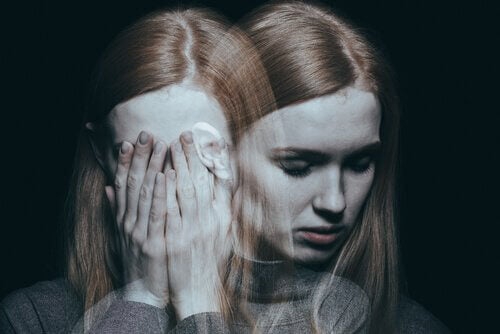The distinctive feature of schizoafective disorder is the presence of symptoms of schizophrenia accompanied by mood symptoms (p. E. g. , auditory hallucinations, disorganized language, and episodes of major depression).
The diagnostic criteria for this disorder have changed over time and most of the time reflect changes in the criteria for diagnosing schizophrenia and mood disorders.
- Despite the changing nature of diagnoses.
- It is still better for patients whose clinical syndrome could be deformed if considered only schizophrenia or simply a mood disorder.
George H. Kirby in 1913 and August Hoch in 1921 treated patients with mixed symptoms of schizophrenia and affective (or mood) disorders. Because these patients had not followed the impaired progression of “early dementia”, Kirby and Hoch classified them in Emil Kraepelin’s group. manic-depressive psychosis.
In 1933, Jacob Kasanin introduced the term “schizoafective disorder” to refer to a disorder with schizophrenic symptoms and symptoms of mood disorders. Patients with this disorder are characterized by a sudden onset of symptoms, often in adolescence.
Patients had a good functional level and a specific stressor often preceded the onset of symptoms. The family history of these patients contained a mood disorder.
Around 1970, two events changed the vision of schizoafective disorder: it was no longer considered a variant of schizophrenia and became considered a mood disorder.
One of these facts is that lithium carbonate has proven its effectiveness and specificity for both bipolar disorder and some cases of this disorder.
The second was a joint study in the United States and the United Kingdom that showed that the variation in the number of patients classified as schizophrenic in the United States and the United Kingdom was the result of a statistical error. In the United States, more emphasis has been placed on the presence of psychotic symptoms as a criterion for schizophrenia.
The concept of schizoafective disorder encompasses the diagnostic concepts of schizophrenia and mood disorders, the evolution of the criteria of this disorder also reflects the evolution of the criteria of the other two, as we have seen above.
The main criterion that should be present in this disorder is that the patient must meet the conditions for an episode of major depression or a manic episode (the person is “full” of energy, only sleeps, makes great plans. Or spend a lot of money, etc. ); meeting the criteria for the active phase of schizophrenia (delusions, hallucinations, etc. ).
Symptoms of mood disorder should also be present as a substantial part of the active or residual phase of psychotic episodes. The DSM (Diagnostic and Statistical Manual of Mental Disorders) also helps determine whether the schizoafective disorder is bipolar or depressive.
A patient is classified as bipolar if this episode is mixed manic (with or without major depressive episodes). In all other cases, the patient is classified as a schizoafective depressive disorder.
According to dsm-IV (Diagnostic and Statistical Manual of Mental Disorders IV), the criteria that a person must meet to be diagnosed are:
Signs and symptoms of this disorder are all those of schizophrenia, manic episodes, and depressive disorders. Symptoms of schizophrenia and mood disorders may occur at the same time or at different stages.
The evolution is variable: there may be cycles in which the person improves and worsens in the manifestation of his symptoms, until reaching a gradual deterioration, many researchers and clinicians have speculated on psychotic symptoms incompatible with mood. The psychotic content (hallucinations or delusions) does not correspond to the patient’s mood.
In general, the presence of this type of symptom in a mood disorder is usually an indicator of poor prognosis, it is also possible that this association is valid for schizoafective disorders, although the data available to date are very limited.
As we said earlier, the symptoms of this disorder are depression, mania and schizophrenia:
It is difficult to demonstrate a clear relationship between drug use and the development of psychotic disorders. However, there is some evidence of the specific use of marijuana.
The more cannabis is consumed, the more likely a person is to develop psychotic disorders, increasing the risk if consumed during adolescence.
A study from Yale University (2009) found that cannabinoids increase symptoms of an established psychotic disorder and trigger relapses. The two components of cannabis that have effects are tetrahydrocannabinol (THC) and cannabidiol (CBD).
In contrast, about half of people with schizoafective disorders use drugs or alcohol in excess. There is evidence that alcohol abuse can trigger the development of a substance-induced psychotic disorder.
For example, the use of amphetamines and cocaine can cause psychotic episodes. Finally, although this is not considered a cause of the disorder, studies show that schizoafective people consume more nicotine than the general population.
The main methods of treatment of the disorder are hospitalization, medication and psychosocial interventions.
The basic principles underlying the pharmacological treatment of these disorders recommend the application of antidepressant and antimanic protocols. Antipsychotics should only be used if short-term patient compensation is required.
If mood-enhancing treatments are not effective in controlling symptoms, antipsychotics would be indicated. As antipsychotics, we can cite haloperidol and risperidone.
Patients with bipolar schizoafective disorder will be treated with lithium, carbamazepine, valproate or a combination there. Patients with depressive schizoafective disorder should receive antidepressants and electroconvulsive therapy before determining their lack of response to antidepressant treatment.
As we have seen, this disorder is very complex, both in its definition and in its treatment, the most important thing, and it should be clear, is that the symptoms of this disorder are those of schizophrenia, manic episodes and depressive disorders. precisely what makes it so complex.

